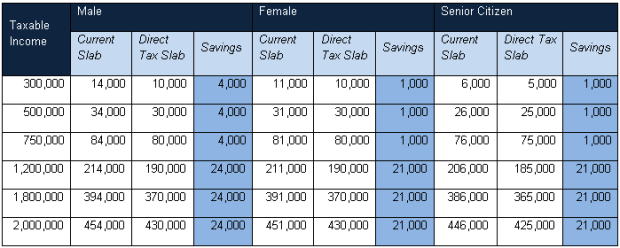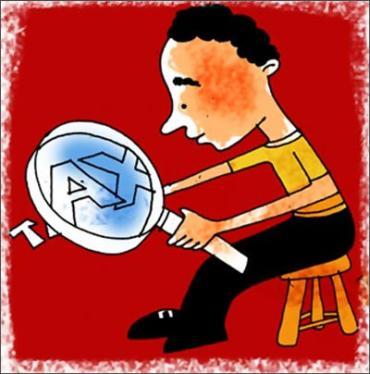 | « Back to article | Print this article |
Direct tax code: How good is it for the salaried?
The long awaited direct tax code bill (DTC) proposes to simplify Indian taxation system. It has been passed by the cabinet without too many glitches only recently. Although there were mixed opinions on how best one had used this opportunity to simplify the tax structure -- no shockers cropped up during the session; further, most of the changes proposed were in line with expectations.
Personal tax slabs
The income tax slabs have been changed; following is the slab which has been finalised for the purpose of taxation.
Female assessees were given the benefit of higher exemptions earlier; however this time round, things have taken a different turn.
There has been a marginal increase in basic exemption limits too.
The table below gives a clear picture of the new tax slabs under the DTC regime.

Direct tax code also chose to do away with cess which is currently pegged @ 3 per cent.
Impact analysis
The increase in slab was a welcome move. However, the slabs are significantly lower than the original proposed slabs. Removal of preferential exemption for female assessees came as a dampener. Education Cess will be removed, which is yet again a good move. Increase in the slabs would translate to savings of Rs 24,000 per annum.
Exemptions
Some of the exemptions you will be allowed under the new DTC:
- House rent exemptions to continue
- Leave travel allowance exemption likely to stay (as per recent indications)
- Leave encashment on retirement is exempt up to specified limits -- this limit was stipulated up to Rs 3 lakh earlier, the same is likely to continue (private companies)
- Medical allowance, which has an upper limit currently of Rs 15,000 per annum, has been increased to Rs 50,000 per annum
Impact analysis
Increase of medical expenses reimbursement limit is in line with the increase in medical cost. This would be a good move for the employees.
Most other components remain unchanged. This is beneficial compared to the initial draft which planned to remove most of the exemptions.
Deductions
Fresh deduction break-up:
- Rs 1 lakh on pension, PF and gratuity funds
- Up to Rs 50,000 for amount paid towards tuition fees, pure life insurance premium and health cover
- Up to Rs 1.5 lakh on amount paid towards interest on housing loan
The latest announcement on DTC mentions that only six schemes will enjoy EEE (Exempt-Exempt-Exempt) benefits: Provident und, PPF, NPS (New Pension Scheme), Recognised PFs, approved life insurance products and annuity schemes.
- Investment in ELSS scheme will no longer attract tax benefit
- Interest deduction on housing loan to continue, limit being Rs 1,50,000 per annum; principal will however, not gain any benefit.
Impact analysis
Continuation of EEE (Exempt-Exempt-Exempt) regime has come as a relief, there are minute nuances / conditions applicable for availing the exemption on maturity amount.
Life insurance has multiple parameters to be satisfied before it becomes eligible for deduction. Premium paid on policies with premium greater than five per cent of sum assured is not deductible. Maturity proceeds on plans where the premium paid in any year during the tenure of the policy is less than five per cent of sum assured, is exempt.
Death benefit received is exempt under all circumstances. Equity linked life insurance schemes are subject to five per cent tax on distribution.
Deduction limit on insurance is inclusive of life, medical and tuition fee, this is a key deterrent; the 5 per cent sum assured threshold is too low -- this may affect the genuine policies. Tax levy on ULIPs could reduce the net yield generated from these plans. However, lower tax rate is welcome.
There has been a drastic reduction of avenues, which will qualify: ELSS, principal on home loan have been shown the door.Some number crunching
The illustration below shows the impact of new tax code on the salaried class.
We have analysed the impact on all three categories: Males, female and senior citizens considering different income groups.
As the tax slab rises net benefit also rises, there were speculation that the brackets will be significantly widened (greater than Rs 25 lakh -- 30 per cent) to enable the higher incomes to benefit, however, this did not happen.
There is also some marginal relief extended by means of increasing the deduction allowed to Rs 3 lakh, whereas earlier the limit was Rs 2.85 lakh (Rs 1.2 lakh as 80 C, Rs 15,000 as 80 D and Rs 1.5 lakh under Sec 24 for interest on housing loan).

Conclusion
Most items laid out were typically expected, no surprises there. Very marginal relief has been provided to salaried class against the hyped expectations.
The Government may not tamper the tax rates during the intermediate budget sessions; hence there will be no surprises on that front hereafter. Direct tax code has in fact simplified and rationalised taxes to some extent, this is an essential part of creating transparency and efficiency within the system.
Key takeaways
- The tax code has taken the midpath approach -- retained some of the exemptions/deductions but only marginally increased the tax slabs
- Exemptions under 80 C has been enhanced, avenues significantly reduced
- The tax code has been designed to make people invest for a longer term; annuities covered under EEE
- Capital gains to stay hence, tax efficiency of capital gains to continue




